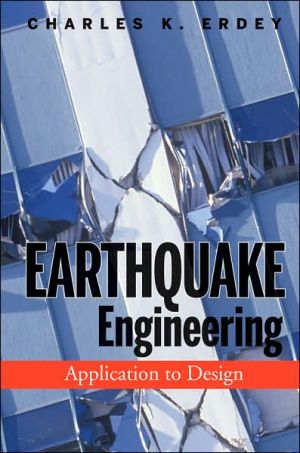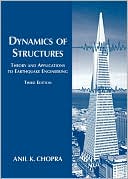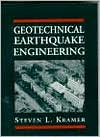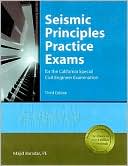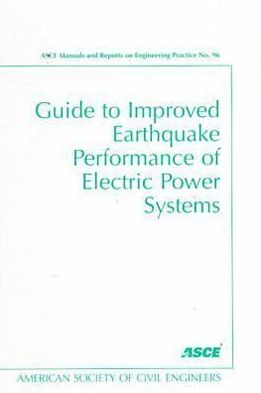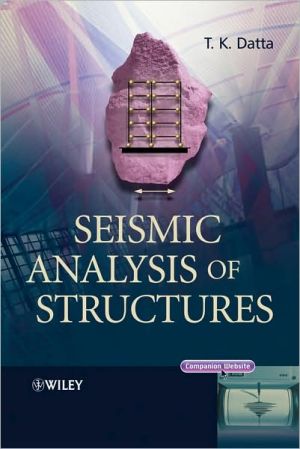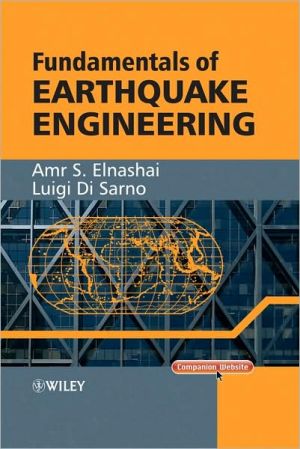Earthquake Engineering: Application to Design
Learn to design code-compliant, earthquake-resistant structures with this practical guide\ Earthquake Engineering demonstrates how to design structural members and joints for seismic resistance. The text guides readers through dozens of structural designs, documenting how to perform each step, make the necessary calculations, and adhere to relevant design codes. Most other texts on seismic design focus on theory and the construction of idealized structures; this text is a radical departure,...
Search in google:
Learn to design code-compliant, earthquake-resistant structures with this practical guideEarthquake Engineering demonstrates how to design structural members and joints for seismic resistance. The text guides readers through dozens of structural designs, documenting how to perform each step, make the necessary calculations, and adhere to relevant design codes. Most other texts on seismic design focus on theory and the construction of idealized structures; this text is a radical departure, presenting actual tested design methodologies that protect structures from the devastation of earthquakes.All the design methods presented by the author comply with the current U.S. building codes. References to these codes are provided throughout the text, helping readers understand how they are integrated into an overall structural design.Everything readers need to create sound designs, from analysis to design implementation, is provided, including:Dozens of worked problems throughout the textComplete reference chapters dedicated to matrices, differential equations, and numerical analysisLatest results of ongoing seismic research, including how these studies are likely to influence future design projectsThe latest 2006 IBC, highlighting significant variations from the 2000 and 2003 editions of the codeDetailed coverage of seismic design for steel moment-resisting frame structures (SMRF), as well as braced-frame steel, concrete, masonry, and wood-framed structuresThis text, with its many worked problems, is ideal for upper-level undergraduates and graduate students. Now that the seismic engineering provisions of the IBC Code apply to the entire United States, this text should also guide practicing engineers not yet exposed to seismic design in designing code-compliant, earthquake-resistant structures.
Preface. Acknowledgments. Notation. 1. OVERVIEW. 1.1.Introduction. 1.2 Concepts, Terminology, and Source of Earthquakes. 1.3 Wave Propagation and Velocities. 1.4 Magnitude of Earthquakes. 1.5 Building Damage. 1.6 Structural Failures. Overall Failure. 1.7 Component or Joint Failure. 1.8 Code Design Forces. Reserve Strength to Counter Extreme Forces. 2. SEISMIC DESIGN REGULATIONS. 2.1 Building Codes. 2.2 The 1997 UBC, A Model Code. 2.3 Building Codes and Other Standards Interaction. 2.4 IBC 2006. 3. REINFORCED-CONCRETE STRUCTURES. 3.1 Introduction. 3.2 Shearing Resistance of RC Beams. 3.3 Development Length. 3.4 The Northridge Experience. 3.5 Case 1. Reinforced Concrete Parking Garage. 3.6 Case 2. Reinforced Concrete Retaining Wall System. 4. SEISMIC STEEL DESIGN: SMRF. 4.1 Design of a SMRF Structure, LRFD Method. 4.2 Design Steps. 4.3 Project Description. Four-Story Office Building. 4.4 Project Layout and Typical SMRF Per UBC 94. 4.5 The 1994 Design. 4.6 Wind Analysis. 97 UBC Chapter 16, Div III. 4.7 Wind Analysis of The Four-Story Building. 4.8 Seismic Zones 3 and 4. 4.9 Earthquake Analysis of the 4-Story Office Building. 4.11 Significant Changes in The 1997 Design. 4.12 1997 Vs 1994 Design. 4.13 Summary of the Procedure. 4.14 Design Strategies. 4.15 Design of Beams. Code Requirements. 4.16 Second-Floor Beam. 4.17 Beam-To-Column Joint. 4.18 Flexural Resistance of Beam-To-Column Joint. 4.19 Shear Tab Design. 4.20 Shear Tab-To-Beam Welded Connection. 4.21 Second-Floor Panel Zone. 4.22 Third-Floor Beam. 4.23 Third-Floor Shear Tab Connection. 4.24 Third-Floor Beam-To-Column Moment Connection. 4.25 Third-Floor Panel Zone. 4.26 Design of Columns. 4.27 Column Final Design Data. 4.28 First-Story Column Design for Compression. 4.29 Column Design Flowchart. 4.30 Design of Third-Story Column for Compression. 4.31 Design of Third-Story Column Splice. 5. SEISMIC STEEL DESIGN: BRACED FRAMES. 5.1 Introduction. 5.2 Project Description: Four-Story Library Annex. 5.3 Wind Analysis. 5.4 Earthquake Analysis. 5.5 Wind and Earthquake Loads. 5.6 Response of Braced Frames to Cyclic Lateral Loads. 5.7 Code Provisions. 5.8 Rules Applicable to Bracing Members. 5.9 Column Strength Requirements. 5.10 Design for Earthquake. 5.11 Strategies for Brace Member Design. 5.12 Brace Members 2 & 3. 5.13 Brace Member 3, First Story. 5.14 Design of Fillet Weld Connection. 5.15 Design Of Gusset Plate, First & Second Story. 5.16 Brace Member 13, Third Story. 5.17 Fillet Weld Design. Third & Fourth Story Gusset Plates. 5.18 Gusset Plate Design, Third & Fourth Story. 5.19 The Vertical Component. 5.20 Column Design. 5.21 Column Splice Design, Third Floor. 5.22 Design of Beams. 5.23 Column Base Plate Design. 5.24 Summary of The Design Procedures. 5.25 The SEAOC Blue Book and the Code. 6. IBC SEISMIC DESIGN OF SMRF STRUCTURES. 6.1 IBC Setup of Seismic Design Forces. 6.2 Design Example. 6.3 IBC Building Categories. 7. MASONRY STRUCTURES. 7.1 Introduction. 7.2 Case 1. Retaining Wall System. 7.3 Case 2. Seismic Vs Wind. 7.4 Case 3. Design of CMU Wall & Precast Concrete Plate. 7.5 Case 4. Retail Store, Masonry & Steel. 8. WOOD-FRAMED BUILDINGS. 8.1 Introduction. 8.2 The Northridge Lesson. 8.3 Case 1. Steel-Reinforced Wood-Framed Building. 8.4 Case 2. Wood-Framed 2-Story Home. 8.5 Case 3. Steel-Reinforced 2-Story Duplex. 8.6 Case 4. Wood-Framed Commercial. 8.7 Case 5. Wood-Framed Residential Building. 8.8 Wood-Frame Garage & Workshop. 8.9 Light-Gauge Steel as Alternative to Wood Framing. 8.9 Case 6. Light-Gauge Steel in a Multistory Project. Appendix to Chapter 8. 9. MATRICES IN ENGINEERING. 9.1 Use of Matrices in Engineering. 9.2 Matrix Addition and Multiplication. 9.3 Matrix Forms. 9.4 Transposition. 9.5 Minor and Cofactor Matrices. 9.6 Determinant of a Matrix. 9.7 Inverse of a Matrix. 9.9 Elementary Row Operations. 9.10 Summary of Matrix Operations. 10. DIFFERENTIAL EQUATIONS. 10.1 Basic Concepts. 10.2 First-Order Differential Equations. 10.3 Separation of Variables. 10.4 Exact Equations. 10.5 The Integrating Factor. 10.6 Second-Order Linear Equations. 10.7 Homogeneous Differential Equations. 10.8 The Characteristic Equation. 11. NUMERICAL METHODS AND ENGINEERING APPLICATIONS. 11.1 Introduction to Dynamic Analysis. 11.2 Equation of Motion. 11.3 Damping. Damped Free Vibration. 11.4 Free Vibrations. Two-Degree Systems. 11.5 Eigenvalues and Eigenvectors. 11.6 Modeling Actual Structures. 11.7 Three-Degree Systems. 11.8 Existence and Uniqueness Theory. Wronskian. 11.9 Driving Functions (FT). Seismic Ground Motion as (FT). 12. METHODS AND TOOLS TO UNRAVEL SECRETS OF EARTHQUAKES. 12.1 The Works of an Earthquake. 12.2 The Vertical Acceleration Component. 12.3 A New Method of Dynamic Analysis. 12.4 Background of the Research. 12.5 The 1994 Earthquake in Santa Monica. 12.6 Analysis of the Actual Structure. 12.7 Results and Findings. 12.8 Nature and Causes of Joint Failure. 13. RECENT AND FUTURE DEVELOPMENTS IN SEISMIC DESIGN. 13.1 Tests on Joints. 13.2 The Dog-Bone Experiment. 13.3 Joint Strain-Hardening, Speed Straining. 13.4 The Mechanism of Joint Degradation. 13.5 Conclusions. 13.6 New Trends. 13.7 Seismic Isolation. 13.8 Engineered Damping. Acronyms. Glossary. Appendix. Computer Analysis. A. SMRF Project Part I. B. SMRF Project Part II. C. Braced-Frame Project. Index.
